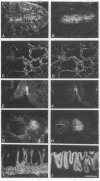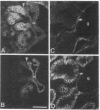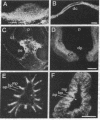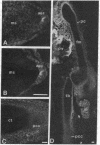Abstract
A reexamination of the expression of cell adhesion molecules (CAMs) during the development of the chicken embryo was carried out using more sensitive immunocytochemical techniques than had been used previously. While the previously determined sequence of CAM expression was confirmed, neural CAM (N-CAM) was also detected on endodermal structures such as the lung epithelium, gut epithelium, and pancreas and on budding structures such as the pancreatic duct and gall bladder. It was also found on ectodermal derivatives of the skin. In most of these sites, N-CAM expression was transient, but in the chicken embryo lung, the epithelium remained positive for N-CAM and liver CAM (L-CAM) into adult life. Thus, at one time or another, both of these primary CAMs can be expressed on derivatives of all three germ layers. At sites of embryonic induction, epithelial cells expressing both L-CAM and N-CAM, or L-CAM only, were apposed to mesenchymal cells expressing N-CAM. Examples included epiblast (NL) and notochord (N); endodermal epithelium (NL) and lung mesenchyme (N); Wolffian duct (NL) and mesonephric mesenchyme (N); apical ectodermal ridge (NL) and limb mesenchyme (N); and feather placode (L) and dermal condensation (N). The cumulative observations indicate that cell surface modulation of the primary CAMs at induction sites can be classified into two modes. In mode I, expression of N-CAM (or both CAMs) in mesenchyme decreases to low amounts at the cell surface, and then N-CAM is reexpressed. In mode II, one or the other CAM disappears from epithelia expressing both CAMs. As a result of the primary processes of development, collectives of cells linked by N-CAM and undergoing modulation mode I are brought into the proximity of collectives of cells linked by L-CAM plus N-CAM or by L-CAM undergoing modulation mode II. Such adjoining cell collectives or CAM couples were found at all sites of embryonic induction examined.
Full text
PDF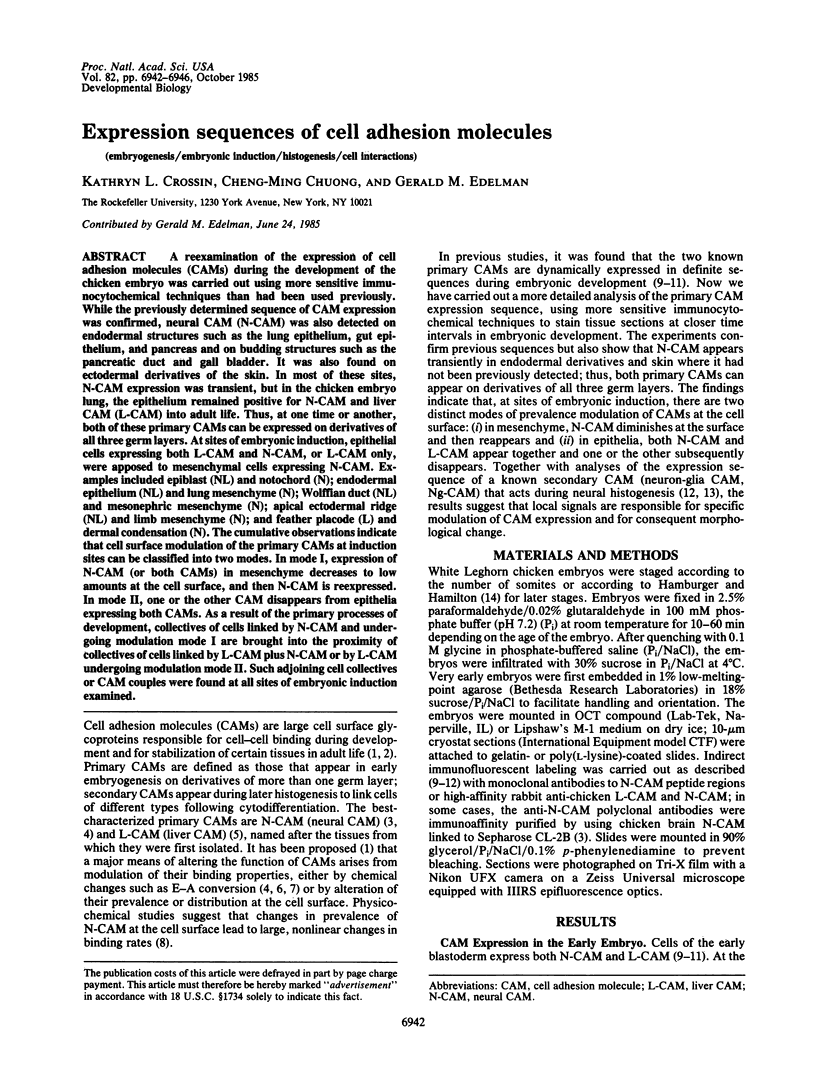
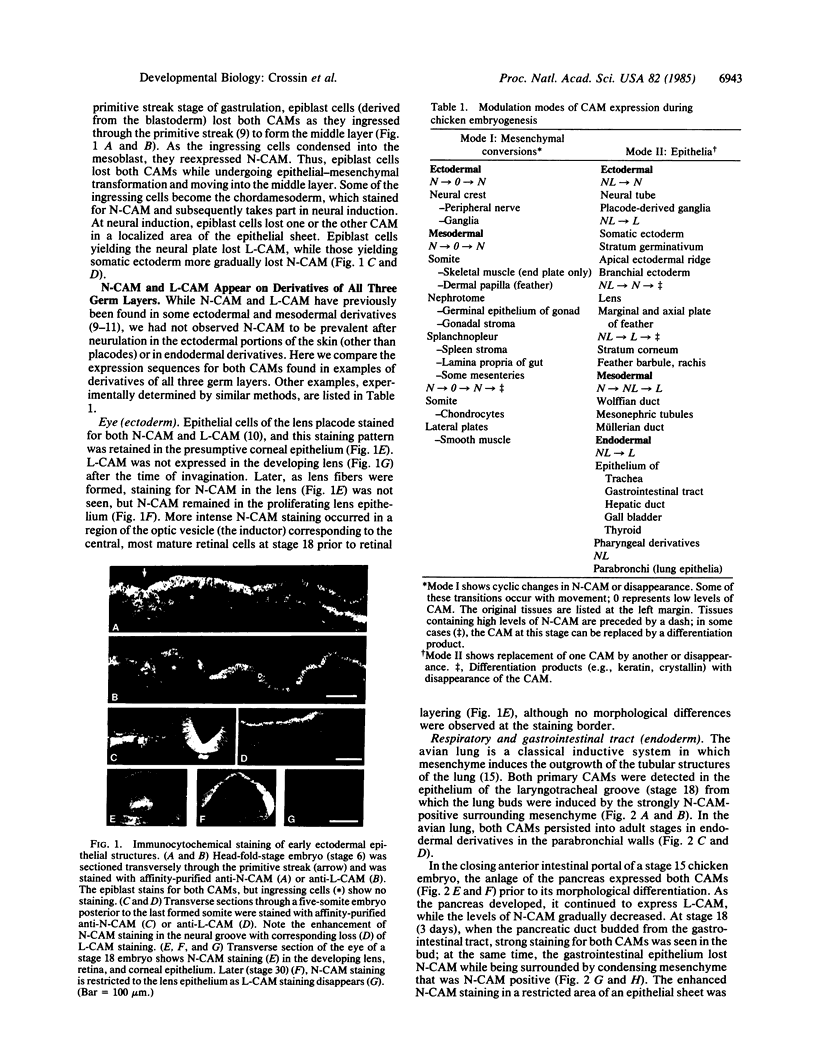
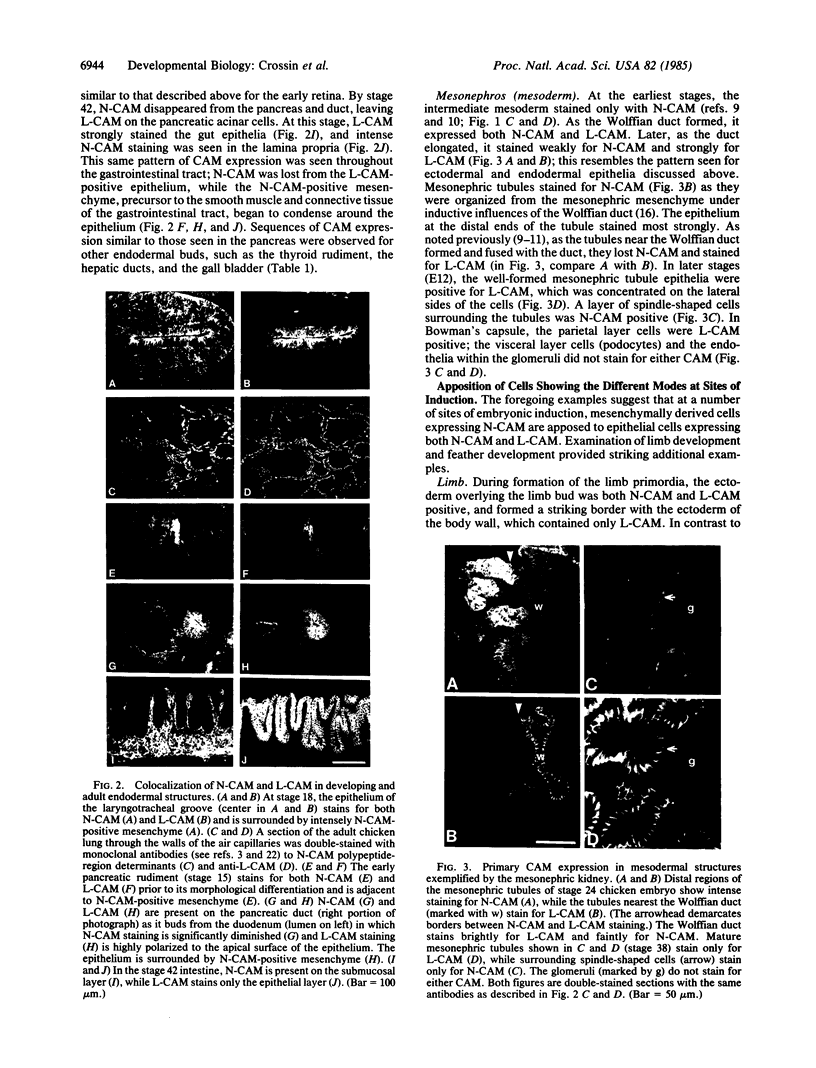
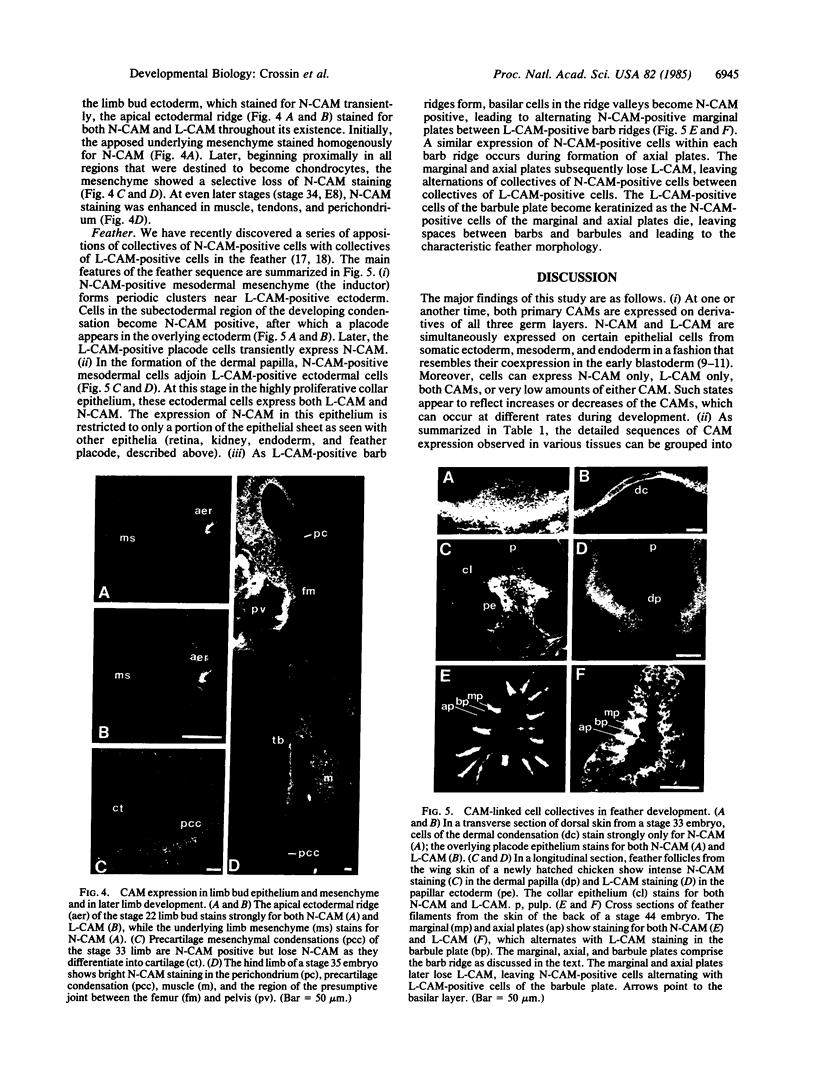
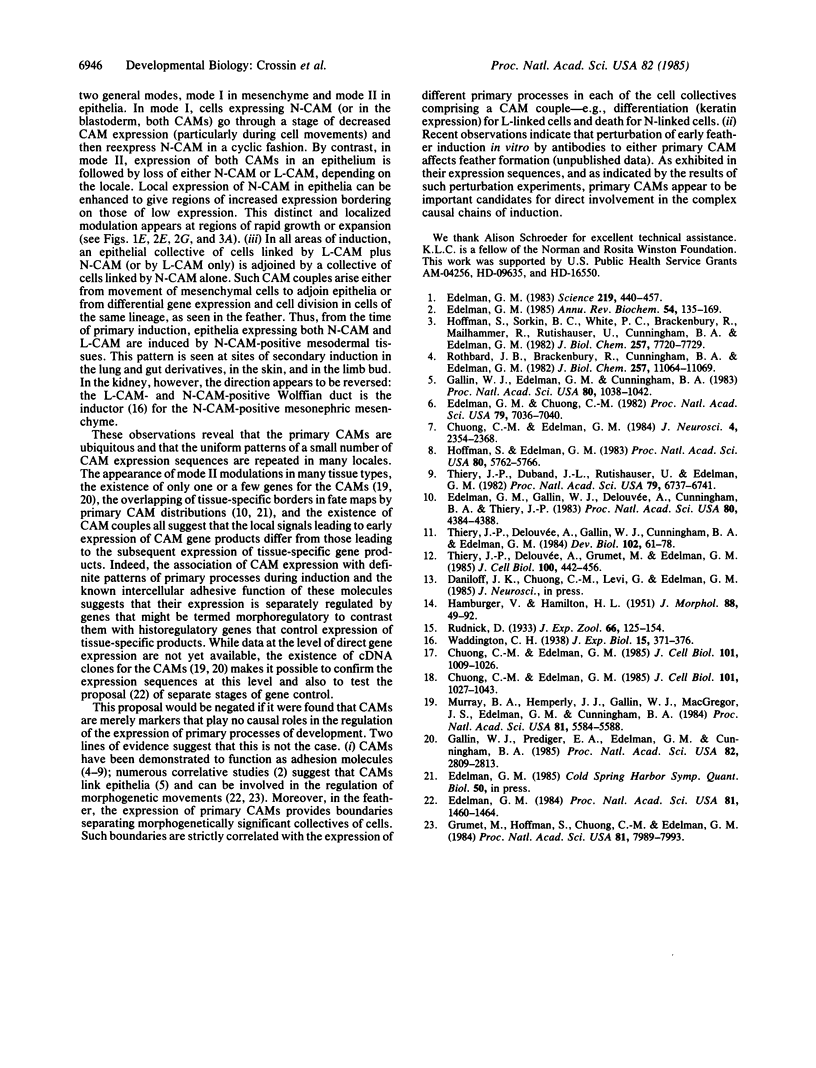
Images in this article
Selected References
These references are in PubMed. This may not be the complete list of references from this article.
- Chuong C. M., Edelman G. M. Alterations in neural cell adhesion molecules during development of different regions of the nervous system. J Neurosci. 1984 Sep;4(9):2354–2368. doi: 10.1523/JNEUROSCI.04-09-02354.1984. [DOI] [PMC free article] [PubMed] [Google Scholar]
- Chuong C. M., Edelman G. M. Expression of cell-adhesion molecules in embryonic induction. I. Morphogenesis of nestling feathers. J Cell Biol. 1985 Sep;101(3):1009–1026. doi: 10.1083/jcb.101.3.1009. [DOI] [PMC free article] [PubMed] [Google Scholar]
- Chuong C. M., Edelman G. M. Expression of cell-adhesion molecules in embryonic induction. II. Morphogenesis of adult feathers. J Cell Biol. 1985 Sep;101(3):1027–1043. doi: 10.1083/jcb.101.3.1027. [DOI] [PMC free article] [PubMed] [Google Scholar]
- Edelman G. M. Cell adhesion and morphogenesis: the regulator hypothesis. Proc Natl Acad Sci U S A. 1984 Mar;81(5):1460–1464. doi: 10.1073/pnas.81.5.1460. [DOI] [PMC free article] [PubMed] [Google Scholar]
- Edelman G. M. Cell adhesion and the molecular processes of morphogenesis. Annu Rev Biochem. 1985;54:135–169. doi: 10.1146/annurev.bi.54.070185.001031. [DOI] [PubMed] [Google Scholar]
- Edelman G. M. Cell adhesion molecules. Science. 1983 Feb 4;219(4584):450–457. doi: 10.1126/science.6823544. [DOI] [PubMed] [Google Scholar]
- Edelman G. M., Chuong C. M. Embryonic to adult conversion of neural cell adhesion molecules in normal and staggerer mice. Proc Natl Acad Sci U S A. 1982 Nov;79(22):7036–7040. doi: 10.1073/pnas.79.22.7036. [DOI] [PMC free article] [PubMed] [Google Scholar]
- Edelman G. M., Gallin W. J., Delouvée A., Cunningham B. A., Thiery J. P. Early epochal maps of two different cell adhesion molecules. Proc Natl Acad Sci U S A. 1983 Jul;80(14):4384–4388. doi: 10.1073/pnas.80.14.4384. [DOI] [PMC free article] [PubMed] [Google Scholar]
- Gallin W. J., Edelman G. M., Cunningham B. A. Characterization of L-CAM, a major cell adhesion molecule from embryonic liver cells. Proc Natl Acad Sci U S A. 1983 Feb;80(4):1038–1042. doi: 10.1073/pnas.80.4.1038. [DOI] [PMC free article] [PubMed] [Google Scholar]
- Gallin W. J., Prediger E. A., Edelman G. M., Cunningham B. A. Isolation of a cDNA clone for the liver cell adhesion molecule (L-CAM). Proc Natl Acad Sci U S A. 1985 May;82(9):2809–2813. doi: 10.1073/pnas.82.9.2809. [DOI] [PMC free article] [PubMed] [Google Scholar]
- Grumet M., Hoffman S., Chuong C. M., Edelman G. M. Polypeptide components and binding functions of neuron-glia cell adhesion molecules. Proc Natl Acad Sci U S A. 1984 Dec;81(24):7989–7993. doi: 10.1073/pnas.81.24.7989. [DOI] [PMC free article] [PubMed] [Google Scholar]
- Hoffman S., Edelman G. M. Kinetics of homophilic binding by embryonic and adult forms of the neural cell adhesion molecule. Proc Natl Acad Sci U S A. 1983 Sep;80(18):5762–5766. doi: 10.1073/pnas.80.18.5762. [DOI] [PMC free article] [PubMed] [Google Scholar]
- Hoffman S., Sorkin B. C., White P. C., Brackenbury R., Mailhammer R., Rutishauser U., Cunningham B. A., Edelman G. M. Chemical characterization of a neural cell adhesion molecule purified from embryonic brain membranes. J Biol Chem. 1982 Jul 10;257(13):7720–7729. [PubMed] [Google Scholar]
- Murray B. A., Hemperly J. J., Gallin W. J., MacGregor J. S., Edelman G. M., Cunningham B. A. Isolation of cDNA clones for the chicken neural cell adhesion molecule (N-CAM). Proc Natl Acad Sci U S A. 1984 Sep;81(17):5584–5588. doi: 10.1073/pnas.81.17.5584. [DOI] [PMC free article] [PubMed] [Google Scholar]
- Rothbard J. B., Brackenbury R., Cunningham B. A., Edelman G. M. Differences in the carbohydrate structures of neural cell-adhesion molecules from adult and embryonic chicken brains. J Biol Chem. 1982 Sep 25;257(18):11064–11069. [PubMed] [Google Scholar]
- Thiery J. P., Delouvée A., Gallin W. J., Cunningham B. A., Edelman G. M. Ontogenetic expression of cell adhesion molecules: L-CAM is found in epithelia derived from the three primary germ layers. Dev Biol. 1984 Mar;102(1):61–78. doi: 10.1016/0012-1606(84)90175-1. [DOI] [PubMed] [Google Scholar]
- Thiery J. P., Delouvée A., Grumet M., Edelman G. M. Initial appearance and regional distribution of the neuron-glia cell adhesion molecule in the chick embryo. J Cell Biol. 1985 Feb;100(2):442–456. doi: 10.1083/jcb.100.2.442. [DOI] [PMC free article] [PubMed] [Google Scholar]
- Thiery J. P., Duband J. L., Rutishauser U., Edelman G. M. Cell adhesion molecules in early chicken embryogenesis. Proc Natl Acad Sci U S A. 1982 Nov;79(21):6737–6741. doi: 10.1073/pnas.79.21.6737. [DOI] [PMC free article] [PubMed] [Google Scholar]




